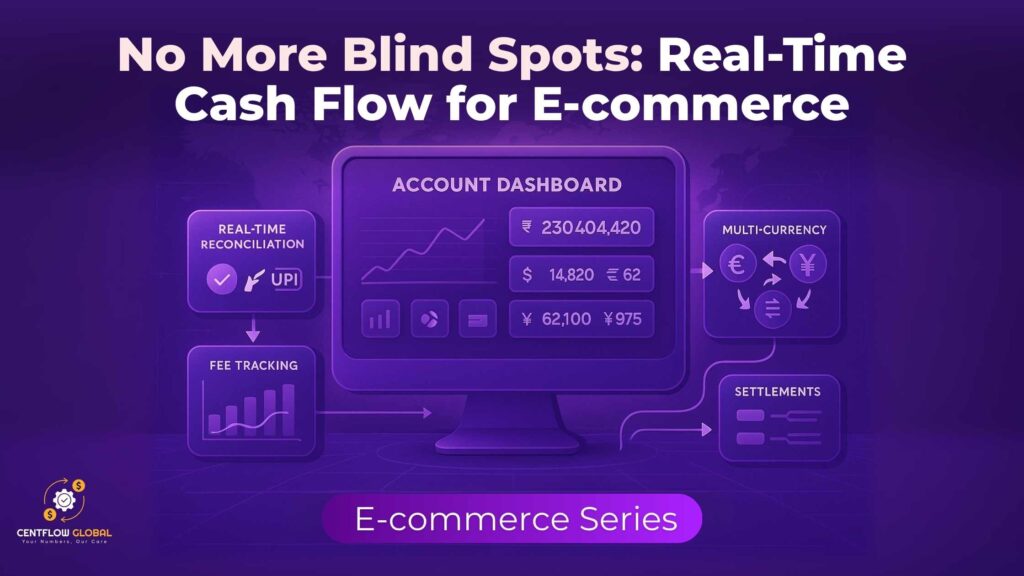
Why Real-Time Reconciliation Is a Game-Changer
The Failure of Traditional Monthly Reconciliation
Many e-commerce businesses that process payments via UPI, cards, and international transactions face complex challenges due to settlement delays that can range from instant (like UPI) to up to 14 days for international card transactions. This creates a web of reconciliation complexities:
- Settlement Timing Mismatches: UPI payments settle instantly, while Mastercard and Amex transactions typically take 2-5 business days to settle.
- Multi-Currency Complexities: International card payments involve currency conversions at variable exchange rates, adding layers to reconciliation.
- Diverse Fee Structures: Razorpay fees vary significantly UPI charges hover between 0.3-0.5%, whereas card payments range from 1.8-2.5%, requiring separate tracking for accurate cost analysis.
Research reveals that companies adopting real-time reconciliation reduce cash flow forecasting errors by 85% and spot discrepancies 30 times faster than those relying on monthly reconciliation cycles.
Comparing Payment Gateways: Settlement, Fees, and Reconciliation Complexity
| Payment Gateway | Settlement Delay | Fee Structure | Multi-Currency Support | API Quality | Reconciliation Difficulty | Recommended Tool |
|---|---|---|---|---|---|---|
| Stripe | 2 days | Simple | Excellent | Excellent | Low | Native / Synder |
| PayPal | 1-3 days | Complex | Good | Good | Medium | A2X / Cointab |
| Square | 1-2 days | Simple | Limited | Good | Low | Native / Synder |
| Razorpay | 2-3 days | Medium | Good | Good | Medium | Cointab / Manual |
| Adyen | 1-5 days | Complex | Excellent | Excellent | High | Cointab / Custom |
| Amazon Pay | 14 days | Very Complex | Good | Poor | Very High | A2X / Manual |
Phase 1: Setting Up Your Bank Feed Architecture
Choosing the right bank feed provider is critical. Your accounting software choice heavily influences your options for connecting bank feeds, especially with major Indian banks and payment aggregators.
- For Xero Users: Xero offers direct integration with over 3,500 global banks, including Indian-specific providers. Simply navigate: Banking > Bank Accounts > Add Bank Account, and search for your bank.
- For QuickBooks Users: Access Banking > Bank Feeds > Connect Account, then select your Indian bank. For faster, secure connections, prioritize banks supporting Plaid integration.
Key Indian Bank Integrations
- HDFC Bank: Supports direct OAuth connections with data delays of 2-4 hours.
- ICICI Bank: Real-time API integration via MX or Yodlee.
- SBI: Most platforms require manual import of bank data.
- Axis Bank: Plaid integration is available in select regions.
Security & Compliance Setup
Bank feed security is governed by RBI standards demanding multi-factor authentication and encrypted communication channels. Key measures include:
- Token-based authentication (avoid storing credentials locally)
- AES-256 encryption for all data transfers
- Automated token refresh to prevent connection failures
Phase 2: Payment Gateway Reconciliation Workflow
Razorpay: A Closer Look
Razorpay’s fee and settlement complexity call for customized reconciliation methods:
- Settlement Timing:
- UPI: Instant settlement to your account
- Cards: Settled within T+2 to T+3 business days
- Net Banking and Wallets: Settled within T+1 business day
- Fee Structure Breakdown:
- UPI transactions: 0.3-0.5% + GST
- Domestic cards: 1.8-2.5% + GST
- International cards: 3.5-4% + GST
- Failed transaction charges: ₹2-5 per failed attempt
- Multi-Currency Processing:
International Mastercard and Amex transactions involve currency conversions requiring:- Accurate capture of exchange rates at the transaction vs settlement time
- Tracking of conversion fees (usually 2-3%)
- Matching USD/EUR transactions to INR settlements with precise currency conversions
Specialized tools like Cointab are highly recommended to manage Razorpay’s multi-currency reconciliation complexity.
Bank Feed Providers Comparison
| Provider | Bank Coverage | Setup Time | Security Level | Real-time Updates | Cost Range/Month | Best For | Data Delay |
|---|---|---|---|---|---|---|---|
| Plaid | 14,000+ | 5 minutes | High | Yes | $0-$50 | SMBs | Real-time |
| Yodlee | 12,000+ | 10 minutes | High | Yes | $10-$100 | Enterprise | 1-4 hours |
| MX | 13,000+ | 8 minutes | High | Yes | $5-$75 | Mid-market | 2-6 hours |
| Direct OAuth | 500+ | 15 minutes | Very High | Yes | $0 | Large banks | Real-time |
| Manual | Unlimited | 30+ minutes | Medium | No | $0 | Small volume | 24+ hours |
Setting Up Automated Reconciliation Rules
To handle India’s complex payment ecosystem, your reconciliation rules must be smart and precise:
Primary Matching Criteria:
- Transaction amount (adjusted for fees)
- Transaction reference number
- Customer identifier
- Settlement date range (+/- 3 days for cards)
Exception Handling:
- Partial settlements due to chargebacks
- Failed transactions and their fees
- Refunds spanning multiple settlement cycles
- Currency conversion differences outside tolerance thresholds
Phase 3: Real-Time Cash Flow Visibility
Building a Financial Dashboard That Speaks Your Business Language
Once your bank feeds and payment reconciliations are automated, the next step is transforming this data into actionable insights. Think of this as your financial cockpit, providing a real-time view of your cash position and flow.
Key Dashboard Components:
- Daily Cash Position: Instantly see balances across all your bank accounts plus pending settlements awaiting clearance.
- Settlement Pipeline: Track pending transactions by each payment gateway with expected arrival dates.
- Fee Analysis: Keep tabs on payment processing fees as a percentage of your revenue, broken down by payment method.
- Multi-Currency Exposure: Monitor your foreign currency balances and understand how conversions impact your cash flow.
Predictive Cash Flow Modeling:
Leverage historical reconciled data to forecast future cash flows with remarkable accuracy:
- Analyze average settlement times per payment method.
- Adjust forecasts for seasonal spikes (like festival sales influencing UPI vs. card usage).
- Project fee trends based on evolving payment mixes.
Studies show AI-powered forecasting tools improve cash flow accuracy by up to 85% when fueled by well-reconciled data.
Phase 4: Advanced Optimization Strategies
Mastering Multi-Gateway Reconciliation and Compliance Automation
If your business uses multiple payment gateways, consolidated reconciliation becomes essential to avoid blind spots and delays.
- Multi-Gateway Orchestration:
- Route transactions smartly: High-value sales might flow through a gateway with lower fees but slower settlement, while UPI payments prefer gateways offering speed and volume discounts.
- Use advanced tools like Cointab or Optimus to aggregate data across gateways for a unified view.
- Regulatory Compliance Automation:
- Indian e-commerce must adhere to RBI reporting standards, especially for foreign currency transactions exceeding threshold limits.
- GST integration is vital, ensuring accurate tax calculations and reporting across diverse payment methods.
- Maintain detailed audit trails from customer payment initiation through bank settlement to meet regulatory demands.
Performance Monitoring and Continuous Improvement
Track, Tweak, and Triumph
Define key performance indicators (KPIs) to measure reconciliation efficiency:
- Aim for >95% auto-reconciliation rate.
- Resolve exceptions in under 2 hours.
- Achieve >90% settlement prediction accuracy.
- Keep manual interventions below 5% of transactions.
Regularly review:
- Weekly exception reports to identify systemic issues.
- Monthly settlement timing for better cash flow predictions.
- Quarterly fee analyses to negotiate better payment processor rates.
Implementation Timeline Snapshot
| Phase | Cash Flow Visibility | Manual Work Reduction | Key Milestone |
|---|---|---|---|
| Day 1-2: Bank Feed Setup | 10% | 5% | Basic bank data flowing |
| Day 3-5: Gateway Integration | 35% | 20% | Payment reconciliation active |
| Day 6-8: Multi-currency Config | 50% | 35% | Currency conversion automated |
| Day 9-12: Automation Rules | 75% | 60% | Exception handling configured |
| Day 13-15: Testing & Validation | 85% | 75% | All systems validated |
| Day 16-20: Go-Live & Monitoring | 95% | 85% | Real-time reporting live |
| Day 21-30: Optimization | 100% | 90% | Continuous improvement cycle |
Common Implementation Challenges and Solutions
- Challenge 1: UPI Settlement Timing Variations
Despite instant settlement claims, UPI can slow during peak periods or bank maintenance.
Solution: Build a 4-6 hour tolerance window into your reconciliation rules to handle peak delays (e.g., festival sales days). - Challenge 2: Currency Fluctuations on International Cards
Exchange rates can differ between transaction and settlement dates, causing reconciliation mismatches.
Solution: Use currency tolerance thresholds (±2-3%) and automated exchange rate lookups tied to transaction dates. - Challenge 3: Complex Fee Reconciliation
Multiple fee types across payment methods complicate matching (processing fees, gateway fees, GST, bank charges).
Solution: Set up distinct fee tracking accounts and automate fee calculations based on transaction specifics. - Challenge 4: Handling Failed Transactions
Failed UPI and card transactions still incur fees that must be reconciled.
Solution: Establish workflows for failed transaction reconciliation and auto-match with gateway failure reports.
Security and Risk Management
Handling sensitive financial data demands top-tier security:
- Encryption: Use AES-256 encryption for all data, both in transit and at rest.
- Access Controls: Implement role-based access so only authorized staff see reconciliation data.
- Audit Logs: Maintain comprehensive logs of all activities and access for full traceability.
Fraud Detection:
Real-time reconciliation powers instant fraud alerts:
- Detect duplicate charges automatically.
- Flag unusual payment patterns with AI-driven anomaly detection.
- Get early warnings for chargebacks and disputes.
Key Takeaways
- Automated bank feeds eliminate manual data entry and provide instant cash visibility across accounts and currencies.
- Payment gateway reconciliation automation slashes processing time by 80% while achieving 99%+ accuracy.
- Handling multi-currency transactions requires specialized tools and tolerance rules to manage exchange rate and settlement timing differences.
- Indian payment ecosystems demand tailored reconciliation strategies, particularly for UPI and international cards.
- Real-time reconciliation implementation boosts cash flow forecasting accuracy by 85% and accelerates discrepancy detection by 30x.
- Compliance automation cuts manual audit preparation time by 90%.
